Any time you set up a guard post, LPOP, or fighting position it is absolutely necessary that those who take your place know where there sectors of fire lie and what is in front of them and how far. This stands especially important if your replacement is jumping into a fighting position in the middle of the night.
Day five of my first deployment to Iraq found me and a fellow soldier one January night standing watch along the perimeter of our forward operating base. We donned our night vision and looked out over the farm fields to our front. My buddy tapped on my shoulder and pointed out what looked like a white van halfway out in the field; understandably in the middle of the night this made no sense. We did not know what to make of it so we searched the tower for a range card or any notes; nothing. We got eyes back on the suspicious item not knowing distance or if anyone might be down there. We did not want to call in something that might sit there every day and look like idiots so we opted to take turns keeping an eye on it for the next four hours.
Midnight to four in the morning nothing stirred in or around the vehicle and the hours kept by. Starring though night vision, especially a PVS 5 or 7, will destroy your depth perception, and is not particularly easy on the eyes. We were replaced by soldiers who we were replacing and told them about the suspicious item. They looked at us like idiots and told us it was a little farm shed with a window. Thanks, I thought.
The moral of the story is that the people around you need to be situational aware of their surroundings, especially if you are holed up in a defensive position. You can find the following military guidelines in almost any common tasks manual.
APPENDIX D
STANDARD RANGE CARD
This appendix describes the various parts of a standard range card. It also provides a detailed discussion of how to complete a range card.
D-1. DESCRIPTION
A range card is a sketch of the terrain a weapon system has been assigned to cover by fire. It contains information that assists in the planning and controlling of fires, the rapid detection and engagement of targets, and the orientation of replacement personnel or units. By using a range card, a gunner can quickly and accurately determine the information he needs to engage targets.
a. A sector of fire is a part of the battlefield within which a gunner is responsible for engaging targets. Sectors of fire are assigned to ensure weapon systems will cover target approaches. Leaders should strive to overlap sectors to cover areas that cannot be engaged by one system. The leader gives a gunner boundaries running between prominent terrain features, or by left and right limits indicated by terrain features or azimuths. If necessary, the leader also assigns a gunner more than one sector of fire, designating one sector as primary and others as secondary.
b. The section or squad leader may also designate anticipated target engagement locations within the sector of fire. Those are recognizable terrain features on or near likely enemy avenues of approach. This information is placed on the range card.
c. Leaders may pick out natural or man-made terrain features that can be used as reference points for locating targets and adjusting direct and or indirect fires. Those features are called target reference points (TRPs). TRPs are requested through the mortar or artillery fire support team (FIST) or fire support officer (FSO). If TRPs are in or near the sector of fire, the leader should point them out and tell the gunner their numbers. If he does, the gunner depicts the TRPs on his range card. Normally, a gunner has at least one TRP, but not more than three, in his sector of fire.
d. Natural or man-made terrain features, such as hills, draws, or buildings, may be within the sector(s) of fire that prevent the gunner from firing in that area. The area blocked by these features is called dead space. All dead space in the sector(s) of fire must be determined so leaders can plan other weapon systems or other types of fire to cover the area (for example, mortars, artillery, or mines). Dead space is indicated on the range card.
e. The length of the sector of fire is normally limited by the maximum engagement range of the antiarmor weapon, but it can be less if any natural or man-made terrain features (trees, fences) prevent the gunner from engaging targets at maximum range. Regardless of what affects it, the maximum engagement range is shown on the card as a maximum engagement line. The squad leader uses a map to determine the distance to the maximum engagement line.
f. All TRPs, anticipated target engagement areas, azimuth and distance to a known point, and left and right limits are numbered on the sector sketch and in the data section with corresponding numbers for quick response.
D-2. PREPARATION PROCEDURES
The section/squad leader’s briefing provides the necessary information for the gunner to begin preparing DA Form 5517-R (Standard Range Card). If he is assigned alternate and supplementary firing positions, he prepares a range card for them also. The gunner prepares the range card by performing the following steps.
EXAMPLE OF SECTION OR SQUAD LEADER’S BRIEFING:
“Our mission is to cover a sector of fire that begins at our present position and goes in the direction of the windmill to the maximum engagement range of 3,750 meters; it extends to the right across the high ground behind the houses, and hill, to the right edge of the orchard and returns here. The enemy should approach from the north and will probably use both Marshall Road and Lewis Road to enter our sector. We must plan on engaging the enemy in this area as soon as he is within range. There are two target reference points within your sector; the road intersection of Marshall Road and Duffell Road is TRP-Charlie One and the road junction of Lewis Road and Duffell Road is TRP-Charlie Two. Use the road junction of Campbell Road and Lewis Road to your left as a reference point to locate your position. The distance from the road junction is 633 meters on an azimuth of 85 degrees.”
a. Draw a sector sketch of the entire sector. Make the sketch as large as possible, not to exceed the largest circle. For a large area covered by trees or woods, draw only the outline and label the area; for example, “woods” or “orchard” (Figure D-2).
Figure D-2. Sketch of area on range card.
b. Draw lines from the weapon position (indicated by the black dot at lower center of range card) to show the right and left limits. Place a number 1 at the end of the left limit line and draw a circle around the number. Place a number 2 at the end of the right limit line and draw a circle around the number (Figure D-3).
NOTE: After drawing left and right limit lines, the weapon symbol can be drawn over the black dot.
c. If there are no limitations, the maximum engagement line is curved and joins the left and right sector of fire boundaries at the maximum engagement range (Figure D-4). If there are limitations, the maximum engagement line is drawn in front of the limiting terrain feature.
Figure D-3. Labeling sector of fire.
Figure D-4. Placement of maximum engagement line.
d. Number the anticipated target engagement areas (ATEAs) from left to right, starting with number 3. Place a number at the maximum engagement range of the target on the range card and circle the number (Figure D-5).
e. Number the TRPs from left to right. Place the number below or next to the TRP on the range card and circle the number (Figure D-6).
f. Place diagonal lines, or the words “dead space,” where dead space occurs (Figure D-7).
g. Use a compass to determine the azimuth from the firing position to the known point. Convert the direction to a back azimuth. Draw a line with multiple arrows from the known point to the firing position. Place a number at the known point and circle the number (Figure D-8).
h. Fill in the marginal information at the top of the card.
(1) Unit Description-SQD, PLT, CO. Never indicate a unit higher than company level.
(2) Magnetic North. Orient the range card with the terrain. Place the compass on the range card. Determine the direction of magnetic north arrow and mark it on the card.
i. Fill in the data section at the bottom of the card.
(1) Position Identification. List either primary, alternate, or supplementary.
(2) Weapon. See Figure D-9 for weapon symbols.
(3) Date. List the day and month.
(4) Each circle equals ______ meters. Write the distance between the circles in meters. To determine the distance, count the intervals from the weapon to the maximum engagement line (as determined by the squad leader). Divide the amount of intervals into the range of the maximum engagement line. This will give the distance between circles (Figure D-10).
Example: 9 intervals into 3,750 meters = 416 meters between circles.
(5) No. (Number). Starting with number 1, list the left limit, the right limit, and locations of ATEAs and TRPs shown on the sector.
(6) Direction/Deflection. Only degrees or the azimuth from the azimuth bevel ring (improved TOW vehicle) is listed. Line through the word that does not describe the information listed.
(7) Elevation. This is only used with a ground-mounted machine gun using the traverse and elevation mechanism.
(8) Range. Distance in meters from the weapon to the TRP or target engagement area.
(9) Ammunition. List the type of ammunition used, if applicable.
(10) Description. List the name of the object; for example, road, windmill, church. If the item is a TRP, also list the TRP number.
(11) Remarks. Enter the weapon’s reference point and any additional information not listed in the range card section. If more space in the data section is needed, use the reverse side of the range card.
Figure D-5. Numbered target engagement locations.
Figure D-6. Target reference points and numbers.
Figure D-7. Dead space indicated.
Figure D-8. Placement of distance and azimuth from a known point.
Figure D-10. Determining range interval on range card.
j. Make two range cards. Keep one at the firing position and give one to the squad or section leader for preparation of fire plans and final coordination of fires. (See Figure D-11 for a completed TOW range card.)
Figure D-11. Example of a completed DA Form 5517-R, Standard Range Card for TOW.
D-3. EXPEDIENT RANGE CARD
In combat, a DA Form 5517-R may not be available. The gunner must then draw a range card on anything available (Figure D-12). Preparation of the expedient range card follows the same procedures provided for the standard range card, but the weapon symbol must be used to indicate the location of the weapon position. The range card must include the following eight items:
Weapon symbol.
Sector of fire.
Maximum engagement line.
Range and azimuth to TRP/ATEA.
Dead space.
Distance and azimuth from a known point.
Magnetic north arrow.
Data section.
Figure D-12. Expedient range card.

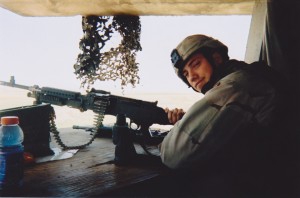
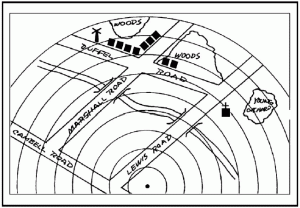
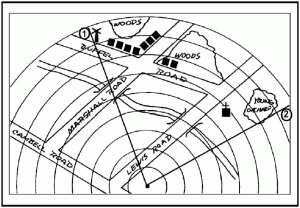
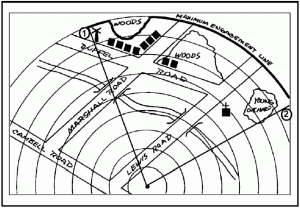

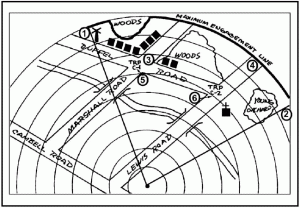
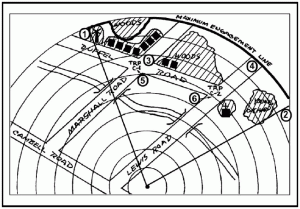
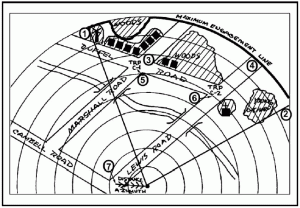
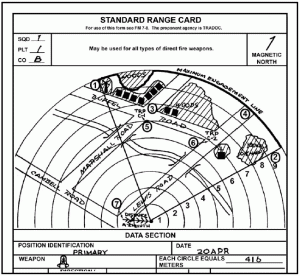
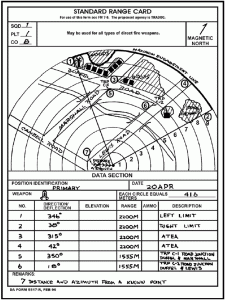
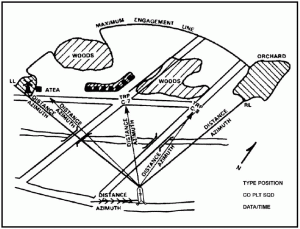
Leave a Reply